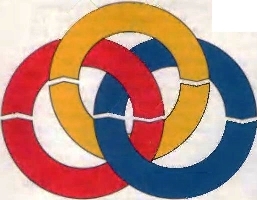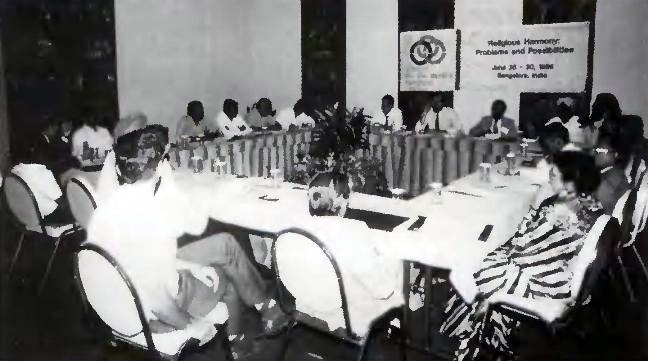![]()
The Words of the Hendricks Family
|
|
The Words of the Hendricks Family |

A major part of god's hope for the world is the achievement of harmony among the world's religions. Through the worldwide foundation of our brothers' and sisters' work, Father today has the means to begin this task substantially. About nine years ago, Father told the professors of the Unification Theological Seminary that they had to unite the world's religions -- in their spare time between teaching classes. Though this seemed unbelievable at the time, that vision was maintained and is now embodied in a very concrete form in the Council for the World Religions, a project of the International Religious Foundation (IRF).
The main activity of the Council has been to sponsor conferences bringing together leaders within religions, such as Jews talking with Jews, Muslims with Muslims, and bringing together leaders of different religions to talk with each other. The general theme is that of religious harmony and dialogue and, more practically, what the religions can do to bring about world peace by working together.
The Council has been in operation for a little over two years, under the directorship of Frank Kaufmann. In its first year the Council organized five conferences, one each for Christians, Jews, Muslims, Buddhists, and Hindus. This year we are holding seven conferences, adding two more to that agenda of five. One of the additional conferences gathered leaders together from the subcontinent of India, representing the different religions within India. Relations between religions in India are at times hostile, especially between Sikhs and Hindus and between Muslims and Hindus. This conference was not without its tensions; all these conferences actually involve tensions between people representing historical religious problems, but that's good, because we can create an atmosphere wherein these tensions can be resolved or wherein we can at least begin to move toward their solution.

"The Worldwide Interfaith Movement: Present Situation and Future Prospects" was the title of the Council's major conference this year. It was held in Bad Nauheim, West Germany, and it involved about 60 religious leaders, mainly from diverse interfaith organizations. There are a few major and many minor organizations in the world today that are working for the same general goal of religious harmony as we are. We decided to get the leaders of these interfaith organizations together to begin discussing mutual visions, strategies, and problems.
As a further dimension, we decided to have leaders of particular religions talk to the interfaith leaders about what effect the interfaith movement is having -- what is good about it and where it is falling short. All the interfaith organizations should appeal not just to a few Christian or Buddhist or Muslim leaders; they must appeal to the man and woman on the street in order to change the consciousness of the whole human race. So we wanted the interfaith leaders to access this vertical connection to the specific religions by talking to the religious leaders themselves.
To a significant degree we accomplished this in our Bad Nauheim conference. Of course that is a tremendous goal, and we didn't complete it, but we made a beginning. Each of the major religions was represented by a speaker from that religion in the addresses given in the mornings and late afternoons. During the middle of each day the conference broke up into discussions groups. Each participant had prepared a paper for discussion, and in the small groups the papers were discussed. Issues were hammered out. The third major component of the conference was the meditation/prayer sessions. Each morning and one evening we had a worship service led by one of the different traditions.
We had some very significant people there. One major religious organization, the World Conference on Religion and Peace, has chapters throughout the world. It's a very effective and strong organization. We had about five major leaders of that organization at the Bad Nauheim meeting. The director of the Indian Institute of Advanced Study and the founder and director of the Indian Institute of Islamic Studies were also there. The most eminent Sikh guru came with one of his disciples. Sikhs on his level carry swords; his disciple always carried with him a very large sword. But the guru was gentle, warm, and embracing. At one point he invited all the children of the participants who were there to his room and he gave them a little homily and blessed them all.
In attendance also were the secretary-general of the World Moslem Congress and one of the six presidents of the World Council of Churches. We had a former president of Bangladesh, the secretary of the World Fellowship of Inter-religious Councils, the president of the International Council of Religions, leaders of various Hindu and Buddhist youth movements, three bishops, three rabbis, and various other important leaders.
It was an impressive gathering. What the conference accomplished was not so much an agreement on doctrines or measures to bring about the goal; what was accomplished to a very impressive degree was rather the agreement of heart among the people. In many other organizations, when the people can't agree with each other on an intellectual level, the whole splits into factions and fails. But our IRF conferences always grow and develop because we don't deem them to be a failure at that point; we are not as interested in intellectual agreement as we are interested in the agreement of heart. That's where this conference really shined. A spirit of warmth and humanity was created. Unity among people is what we are about. The more people we can bring into this experience, the more we can hope for a real breakthrough in religious interaction.
With all that said, however, this conference did have a significant intellectual component. The man who is one of the presidents of the World Council of Churches gave a speech in which he said that the world religions cannot be united except by a new religious movement. They cannot be united from below. A new religious spirit must emerge (though he didn't say it that bluntly) -- a new religious movement with its own symbols, its own ceremonies, and its own content that can transcend and embrace the various present-day religions. It struck me very deeply that what he was saying is absolutely true, and that our movement has the potential to fulfill that world-historical role.
The most inspiring thing for the leaders at this conference was hearing about the Religious Youth Service (RYS) [see p. 00]. This conference followed directly upon the completion of the RYS project in the Philippines. Rev. Kwak himself came from the Philippines to this conference, and another brother who was working there with the RYS came and brought slides with him. The interfaith leaders are saying that the interfaith movement needs to do something, needs to accomplish something practical. People realize that there's been enough talking, and that what's needed is some concrete project that people can work on together. And we could show them:
Here it is! Many of them realized this, and were very inspired to see that Rev. Moon has found a way to bring the religions together to work jointly on a service project for the benefit of humanity. Thus our movement offers them significant possibilities: not only on an ideological level in terms of new symbols and a universal theology, but on a very substantial level with the Religious Youth Service.
Religious leaders are worried about their young people, wondering what their young people can do and what religion can offer them. Young people are drifting way into secularism and materialism. They aren't accepting the old answers and traditions. Now we can tell them that there is a way that young people can channel their energies toward helping the world, deepen their faith in their own tradition, and at the same time connect to other young people on a global level in service to their fellow human beings, thus creating a universal human community. This is quite inspiring to all religious leaders, and I'm sure also very inspiring to God.